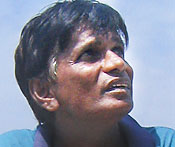BREAKWATER OR BREAKDOWN
Six sites were surveyed - in the south and southwest, Kapparatota/Weligama, Polhena, Unawatuna, Hikkaduwa, and Rumassala, and in the northeast, Trincomalee's Dutch Bay.
Most of the damage was caused by the shifting around of dead coral and coral rubble leftover from 1998's bleaching, says Arjan Rajasuriya, from Sri Lanka's National Aquatic Resources Research & Development Agency (NARA).
This damaged the healthier corals.
But most of the damage took place in shallower waters, up to five metres deep. Debris carried out to sea and shifting sands also caused some siltation, says Rajasuriya.
Also, worse damage was observed on land where reefs had been mined for coral lime.
Checks and balances
The nursing grounds will be particularly affected by the damage, says Coral reef expert Jerker Tamelander, coordinator of the Asia Regional Marine Programme at IUCN, the World Conservation Union.
The damage done to the fragile, branching corals will affect the ornamental fish that live on them. If they lose their habitat, they will perish. "The juveniles haven't even had time to reproduce yet," said Tamelander.
Indeed, warning signs have started appearing in areas such as Kalmunai and Kattankudi. Divers report that their daily ornamental fish catch has halved since the tsunami.
"Every fish has its role in the great ecosystem," says Tamelander, adding that man-made damage to the reefs has removed natural controls that would normally keep the ecosystem in balance.
"There are about a million species living on one coral reef," he said. "When you take one species out, you change the dynamics of the reef."
"So the reef can't regenerate fast enough, and it is weaker too."
This holds sinister implications not just for the future of Sri Lanka's marine environment, but also for the industries and people whose livelihoods are inextricably linked to it.
Fragile balancing act
Similarly, this recent blow to Sri Lanka's marine ecological system - albeit compounded by years of poor fishing practices and unrestrained harvesting - will likely deepen the country's socioeconomic concerns.
Sri Lanka seems to be in the middle of a fragile balancing act of weighty socioeconomic and ecological concerns.
For now, government action focuses on sustaining livelihoods.
While no-dwelling areas have been demarcated about 100 metres from the coast, storage facilities, on the other hand, are permitted.
Fishermen and divers have started work once more after a lull period following the tsunami. Till the socioeconomic end of the scale is relatively stable, it looks like Sri Lanka's ecological concerns will have to wait.
"Implementation of existing regulations is almost absent," says Rajasuriya.
"There are areas where blast fishing is carried out freely. It is unfortunate that we are incapable of implementing even the simplest of regulations against these destructive fishing methods."
According to Rajasuriya and Tamelander, who were studying Sri Lanka's reefs intensely even before the tsunami, a number of sociopolitical reasons underlie the persistent reef degradation.
« prev | next »
